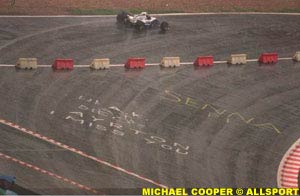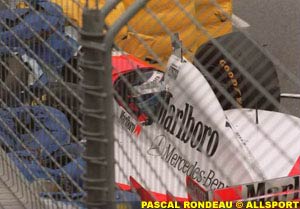|
Last year, Atlas F1 ran a series of articles that investigated the technical areas involved in design, development, and construction of an F1 car. Now, a year later, Will Gray picks up where he left off, and dives deeper into the technical analysis of Formula One.
Part 10: Lifesaving in a dangerous game - Safety
Modern Formula One is safe. It took one weekend at Imola in 1994 to shatter that statement and send the governing bodies into massive discussions on how to prevent such a tragic occurrence happening again. Since then, the safety advances have been astounding. So is the new modern F1 car safe? You must be joking! How can travelling around on a road at 200 miles an hour be safe? The sport will never be 100% risk-free, but the aim of the safety developments is not to achieve this, it is to minimise the risk without minimising the spectacle.
 There are two areas to consider for safety: the tracks and the cars. The GPDA (Grand Prix Drivers' Association) discusses the designs of tracks, the positioning of tyre barriers, and the size of run-off areas and gravel traps at every circuit they race on. The sudden influence of the Imola disaster was seen during that season as straights sprouted makeshift chicanes and the most impressive high speed corner in F1, 'Eau Rouge' at the Belgian Spa-Francorchamps circuit, was turned into a trundle round the cones. Now some structure has been introduced to track development, and better solutions to retaining high speeds whilst increasing safety are being found. There are two areas to consider for safety: the tracks and the cars. The GPDA (Grand Prix Drivers' Association) discusses the designs of tracks, the positioning of tyre barriers, and the size of run-off areas and gravel traps at every circuit they race on. The sudden influence of the Imola disaster was seen during that season as straights sprouted makeshift chicanes and the most impressive high speed corner in F1, 'Eau Rouge' at the Belgian Spa-Francorchamps circuit, was turned into a trundle round the cones. Now some structure has been introduced to track development, and better solutions to retaining high speeds whilst increasing safety are being found.
Larger run off areas are one option, but these send the spectators even further back from the track, and more efficient speed reducing methods are being sought. The current gravel traps seem to make a car airborne when it enters at high speed, and often fail to slow it down before reaching the barrier, but unfortunately they are perfect for stopping a car, which has gently spun after losing traction, from getting back into the race. Some say these should be replaced with high grip tarmac surfaces, others say keep the gravel traps and incline them - it's a big debate. One certainty is that the car will crash at some point, so it should be made to do so in a way that it has been designed to cope with.
Cars are designed to cushion the force, and deform on impact, rather than be rigid and remain intact when they meet their unfortunate end in a barrier. This is because a driver cannot withstand high accelerations or decelerations. When an object moving at 100 mph hits an non-fixed object moving at 0 mph, the 100 mph object will slow down, and transfer some of its speed onto the 0 mph object. However, if this 0 mph object is fixed to the earth (as in the case of a wall), it wonít budge, and the moving object will have to decelerate from 100 mph to 0 mph in a fraction of a second. If that object is a car, with a driver inside, it's going to hurt! The cars, therefore, have deformable impact structures all around them. They are constructed from what is called aluminium 'honeycomb', for reasons that it looks like the honeycomb in a beehive. This flimsy material, when sandwiched between layers of stiff carbon fibre, creates a strong structure. When excessive force is applied from a certain angle, however, the honeycomb structure buckles and crumples to take away some of that force imparted to the vehicle on impact.
These structures are situated in the nosecone, the sidepod area, and the gearbox area at the rear of the car - so all areas are covered. The cars must be able to pass stringent crash tests for these areas performed at national safety institutions in the UK (such as the Motor Industry Research Association, and Cranwell) before the season or after any structural development by the team, to ensure safety is not compromised by designers. To cushion the impact of a crash further, tyre barriers are used all around the track. There are rules here too, which stipulate the thickness of barrier required for a given type of corner, and the tyres in these barriers have an elastic property in them which make them effectively unfixed, so some of the velocity from the car is absorbed by the flexing of the barrier on impact, reducing the force transmitted to the driver.
The deformable crash structures on the car take a great deal of ferocity out of the impact, but the driver still experiences forces we could never imagine on impact. In a crash in Australia in 1995, Mika Hakkinen is said to have instantaneously sustained a deceleration of 150 times the force of gravity, and in the following whiplash he fractured the base of his skull and bit his tongue. Until recently, the driver's neck had no resistance to movement, and his head could be violently flung around by the force of the impact, with a high risk of impacting on the cockpit structure. Now that safety is paramount, cockpits are wider, longer, and have higher sides, with rear and side headrests made of a special cushioning foam which gives much better protection in a crash.
 Airbags have been investigated for extra protection, but in testing, the large longitudinal decelerations experienced in simply braking for corners were found to be high enough to deploy the bags accidentally. To compensate for the lack of airbags, the steering wheel is itself cushioned and slightly flexible, there is a deformable honeycomb construction in its centre, and the whole steering column is designed (and tested) to retract upon heavy impact. The seatbelts have give in them so that the driver doesnít feel the full impact deceleration, and the wheel is positioned far enough from the driver to (in theory) prevent his head hitting it on impact. In addition to this, a new restraint system for the driverís head has been recently introduced. This allows unrestricted movement for normal use, but offers slow-growing, minimised jerk resistance if the head travels further and faster than is normally expected. Airbags have been investigated for extra protection, but in testing, the large longitudinal decelerations experienced in simply braking for corners were found to be high enough to deploy the bags accidentally. To compensate for the lack of airbags, the steering wheel is itself cushioned and slightly flexible, there is a deformable honeycomb construction in its centre, and the whole steering column is designed (and tested) to retract upon heavy impact. The seatbelts have give in them so that the driver doesnít feel the full impact deceleration, and the wheel is positioned far enough from the driver to (in theory) prevent his head hitting it on impact. In addition to this, a new restraint system for the driverís head has been recently introduced. This allows unrestricted movement for normal use, but offers slow-growing, minimised jerk resistance if the head travels further and faster than is normally expected.
Despite all these measures, accidents still happen, and in practice for the 1999 Brazilian Grand Prix, Ricardo Zonta was injured when his head hit the barriers, despite all the head protection. At such speeds it is difficult to design anything which will protect the driver 100%, but if all goes very wrong, the seat is designed to be removable with the driver in place. Once the standard driving belts are removed, other belts can be fed in to strap the legs (just above the knees), hips, and torso in place, and a head stabilisation board can be attached, including a chin strap to hold the head firm. The driver can then be extracted without any movements which could damage him further. Fire crews are usually on the scene almost before the car stops, and safety crews arrive within seconds of an accident. The crew will assess the injuries, stabilise the driver if possible or necessary, try to keep him conscious, and extract him in the best way possible.
As much as the sport must be safe, the racing must not suffer for it. Cars and tracks are a world away from those back on that fateful day in 1994, and many Formula One drivers owe their life to the hundreds of people involved in improving the safety of their sport.
|

